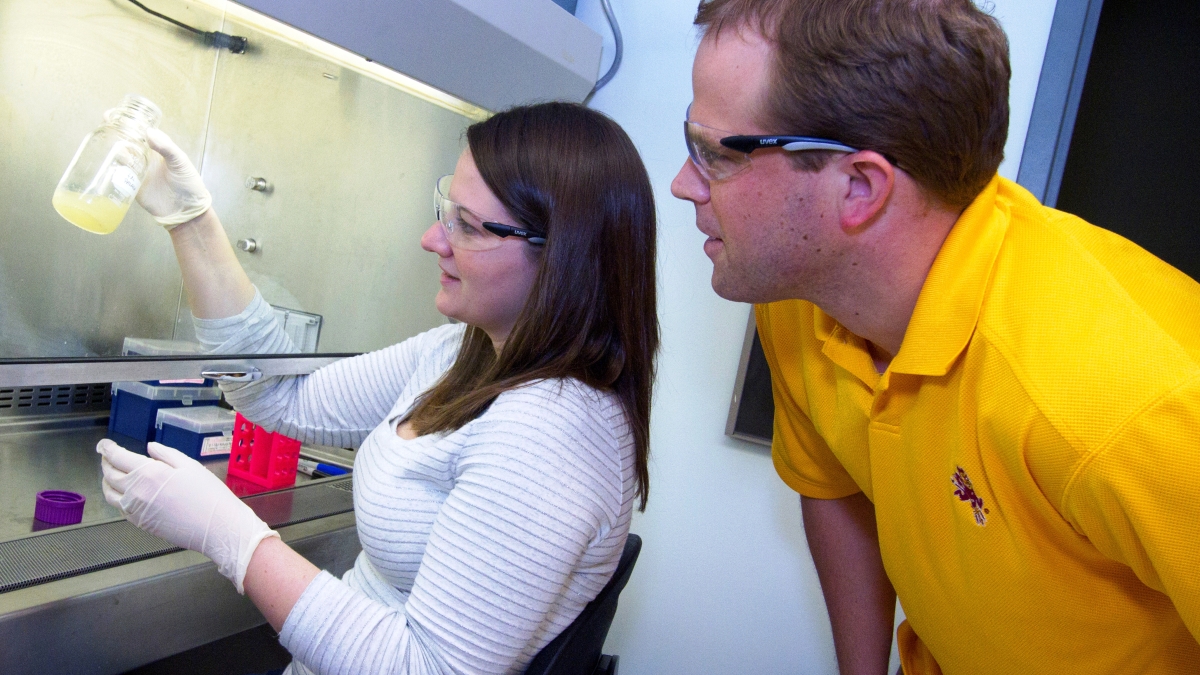Making styrene from biomaterials would bring big benefits

Styrene is one of the major building-block chemicals used to make many of the rubbery polymers and plastic materials we use today. More than 6 billion tons of it is manufactured each year in the United States alone, most of which goes into producing insulating materials, automobile tires, footwear, medical devices and hundreds of other widely used products.
The problem is that all styrene is currently derived from a dwindling resource – petroleum – and its production requires one of the most energy-intensive processes in the petrochemical manufacturing industry. More than three metric tons of steam is necessary to produce just one metric ton of styrene.
That excessive energy consumption also produces significant amounts of carbon dioxide, contributing to the detrimental buildup of greenhouses gases in the atmosphere.
At Arizona State University, David Nielsen and Rebekah McKenna are seeking ways to make styrene – and other common petrochemicals – using renewable resources. They want to produce materials that are more sustainable, require less energy to produce, and alleviate negative environmental impacts when they are manufactured.
Nielsen is an assistant professor of Chemical Engineering in the School for Engineering of Matter, Transportation and Energy, one of ASU’s Ira A. Fulton Schools of Engineering. McKenna is studying to earn a doctoral degree in chemical engineering.
They’re experimenting with engineering microorganisms to act as catalysts for making styrene from renewable resources – in this case biological materials, like sugars from plants.
The bacteria they have genetically engineered for that purpose has drawn attention from peers in their field. A report on their work was first published in the international science and engineering journal Metabolic Engineering, and then later appeared in Nature Chemical Biology as a featured “research highlight."
This past summer, McKenna was one of only a handful of student researchers selected by the Society for Industrial Microbiology to give a presentation at its annual meeting. Her report, “Styrene Biosynthesis from Renewable Resources,” earned the conference’s Best Student Oral Presentation award.
“What we’ve done is create a new metabolic pathway,” Nielsen explains. “We’ve found the particular genes and enzymes required to achieve the necessary chemistry, and we have strung them together in a way that enables our engineered bacteria to function as a sort of biological catalyst. In this way the cells can perform all of the biochemical reactions required to convert sugars like glucose into styrene.”
He and McKenna are doing what he describes as building “microscopic microbial chemical factories,” designed to synthesize the raw ingredients required to make products with characteristics identical to those that in the past have been derived only from petroleum.
If that is achieved, it could be possible for these chemicals produced from renewable materials to “plug directly into existing infrastructure, and be ready to use in current manufacturing systems that provide many of the products we use every day,” Nielsen says.
The next leap – a particularly challenging one – involves further improving the bacteria and scaling up the process to where styrene yields can be produced from renewable resources in as economically viable a way as styrene made from petroleum.
Nielsen sees potential for his and McKenna’s research to contribute to engineering efforts to develop other commonly used chemicals, fuels, and materials from renewable resources that would “create whole new markets for renewable biochemicals and biopolymers.”
At the very least, “we hope to be able to develop viable renewable alternatives for the bio-plastics industry,” he says. “From there, we might be able to begin making all sorts of new products from renewable, biological materials,” including new kinds of fuels.